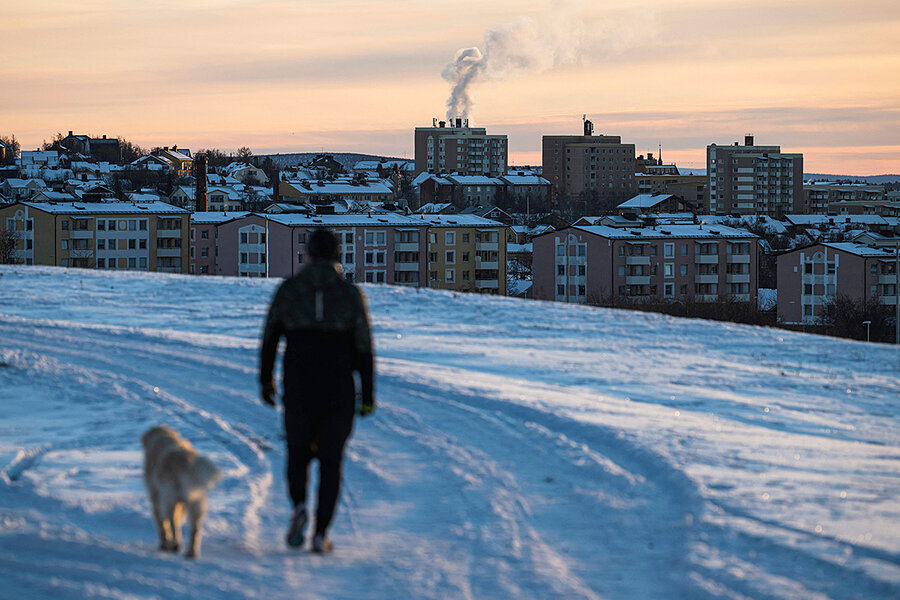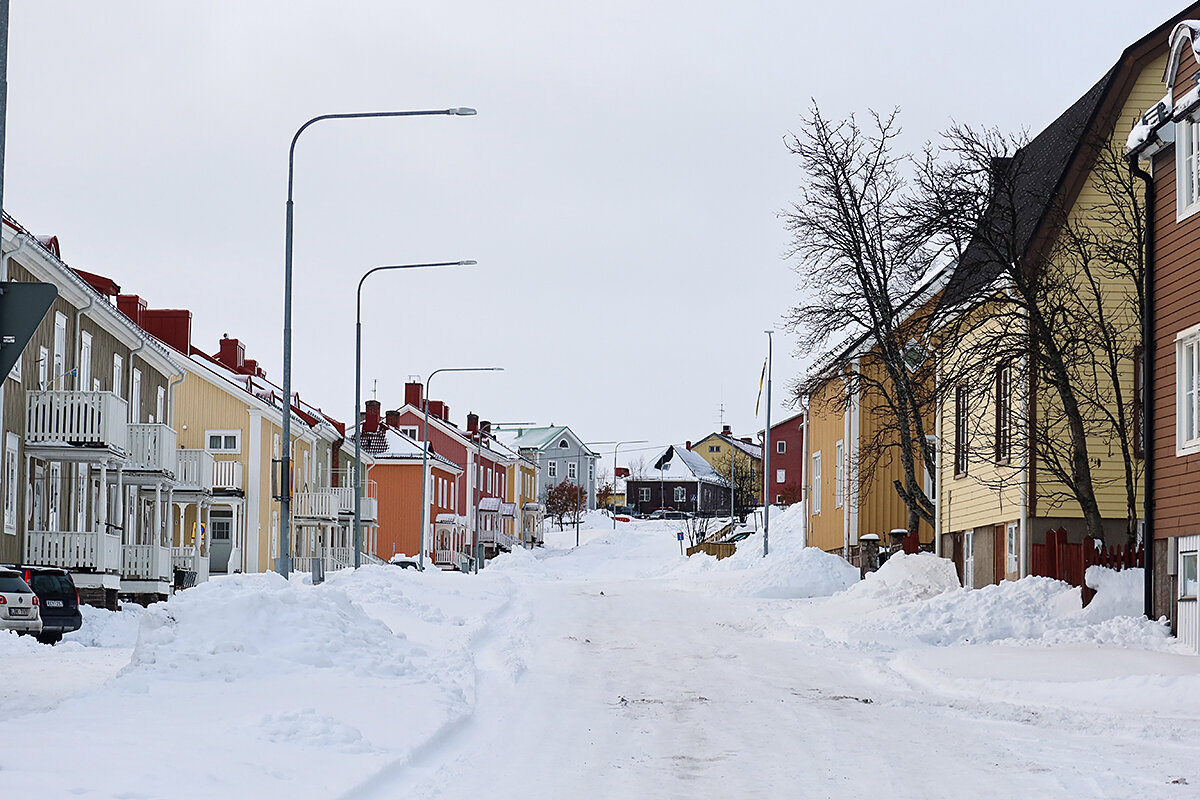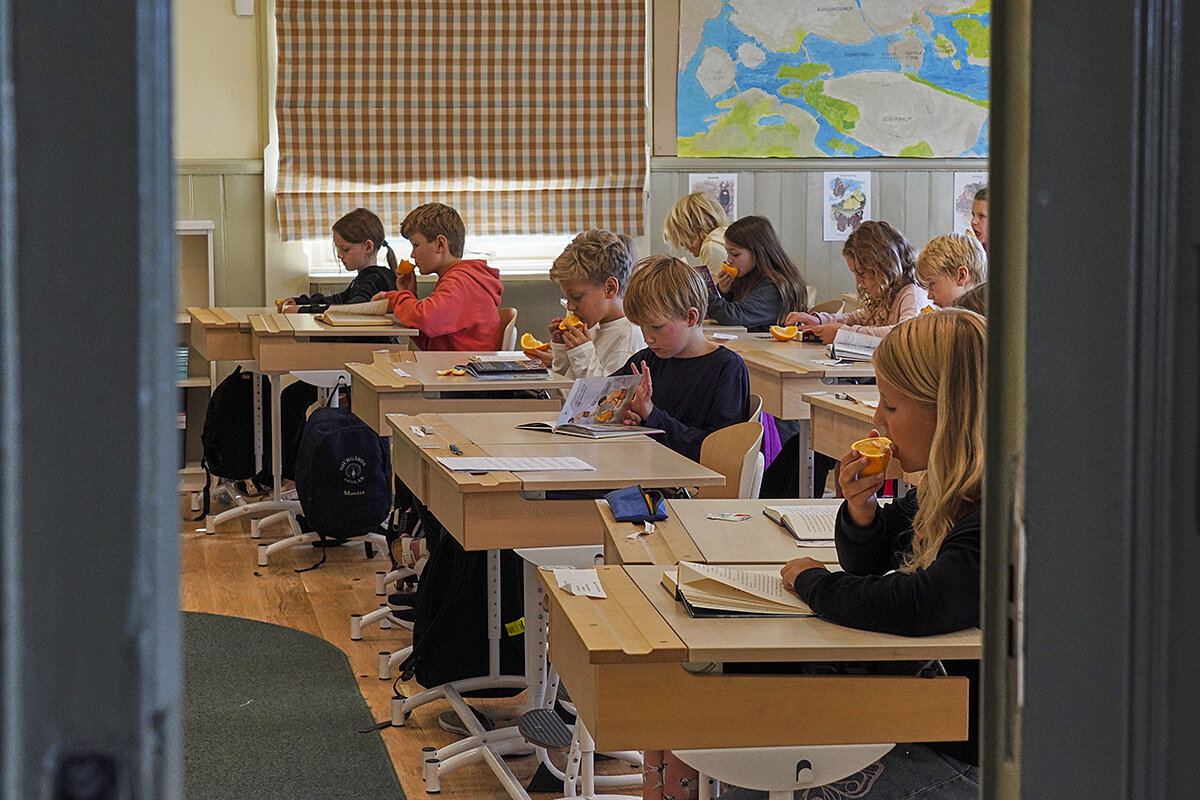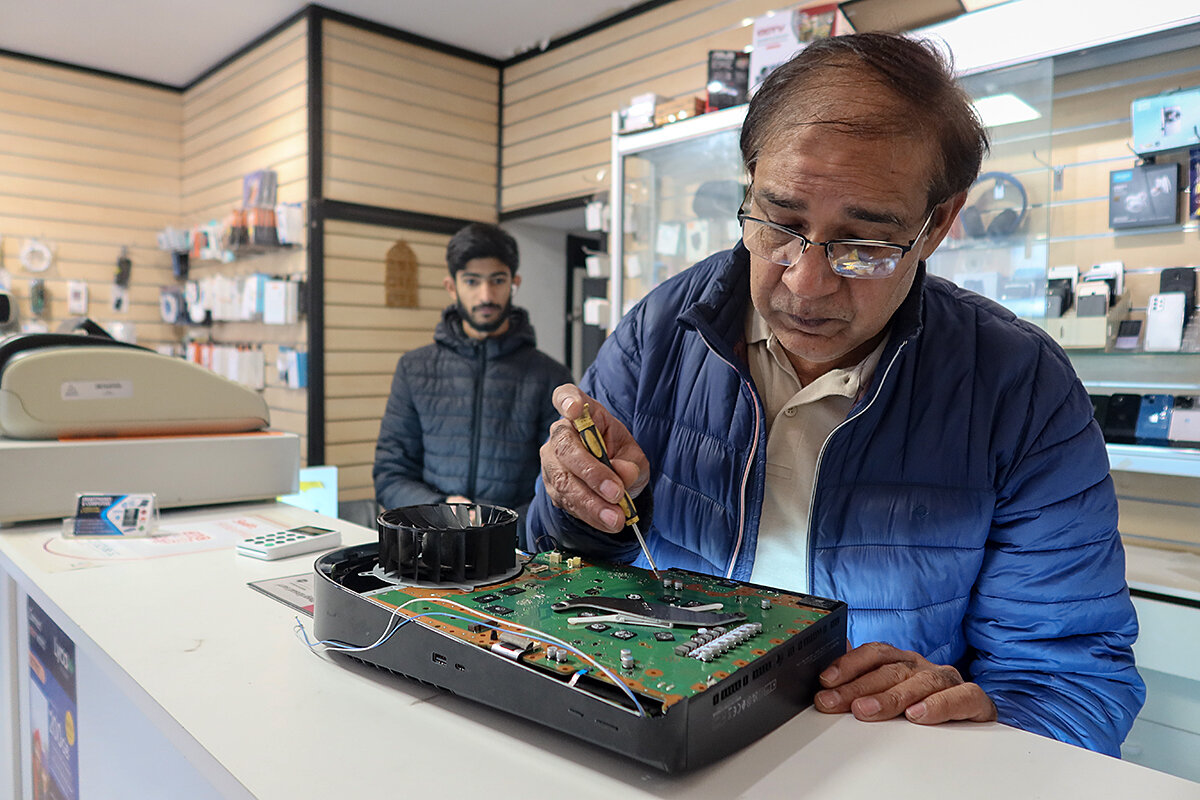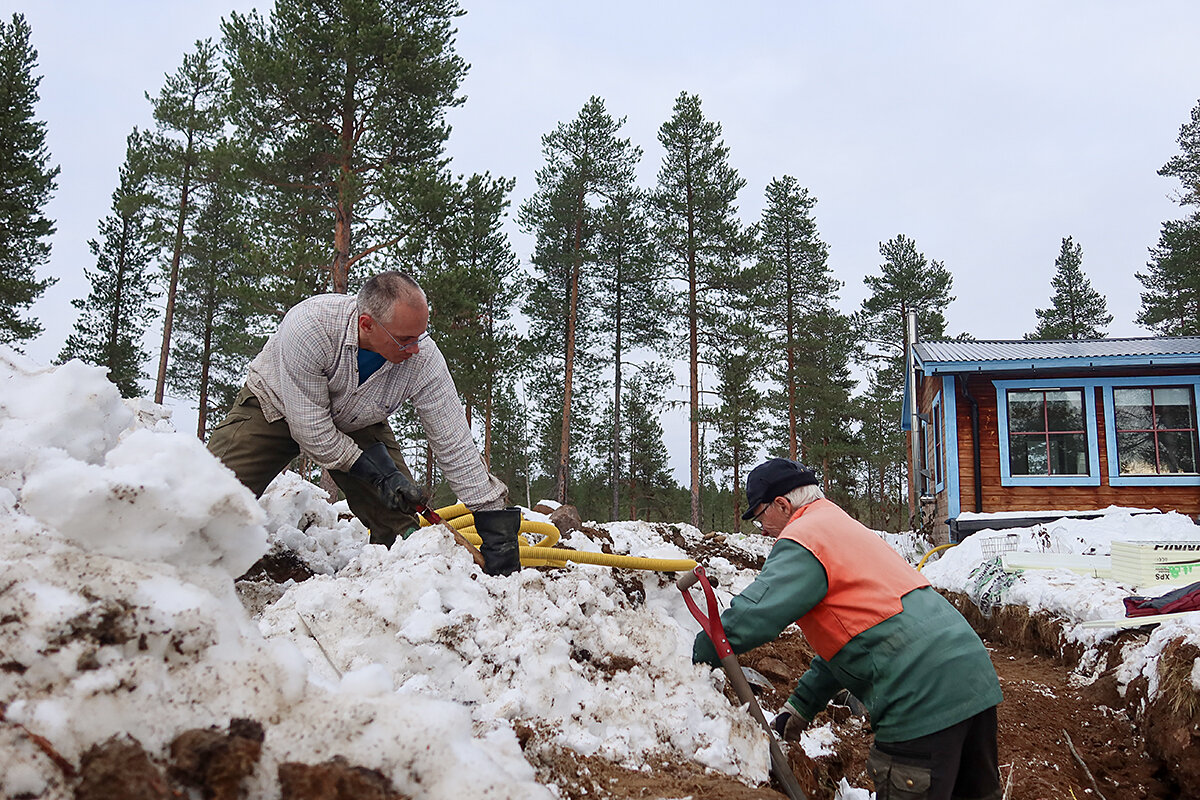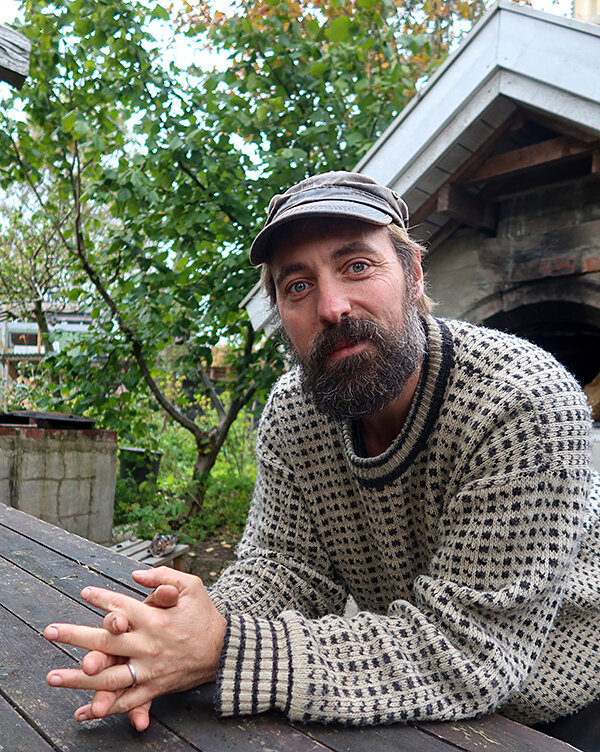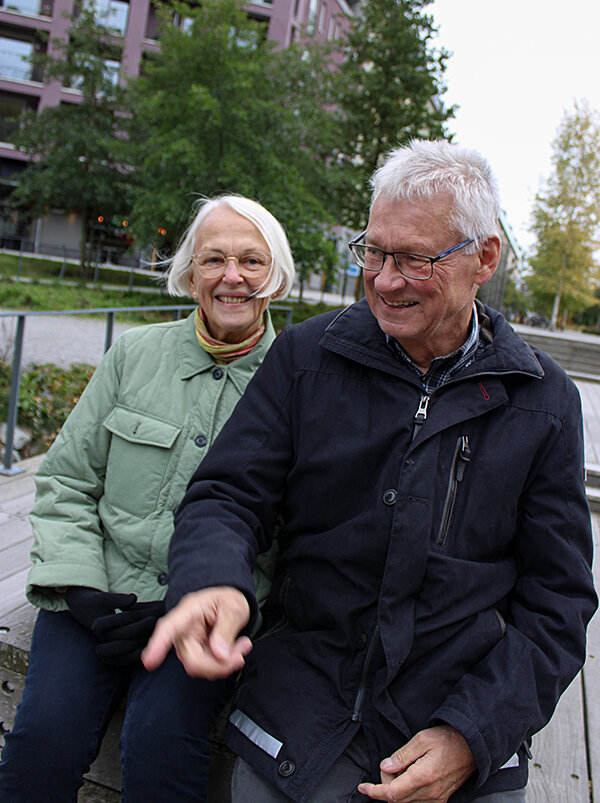Is enough still enough? Sweden reckons with its culture of ‘lagom.’
Loading...
| Malmö, Höör, Stockholm, and Jokkmokk, Sweden
Despite the bitter cold, muralist Havana Dadian is creating a scene from the 1940s on a whitewashed wall in Malmö, Sweden. In her view, she is painting for the future of her country.
“Something has happened, and it’s not so certain anymore – the safety, feeling that you have everything you need,” she says.
Why We Wrote This
A story focused onSweden’s “lagom” culture promises not too much and not too little, but just enough for everyone. Some wonder if that balance is getting lost, and whether it can be revived.
At stake is a uniquely Swedish philosophy: lagom. It means not too much, not too little, but just enough.
“Lagom is one for all and all for one,” says Ms. Dadian.
Sweden consistently ranks in the top 10 countries with the highest levels of satisfaction, but it appears to be reaching a turning point, as social services come under increasing stress and politics reach unprecedented levels of polarization. Fears about the erosion of social trust are growing. Some wonder whether the economic pie is still big enough to go around. Others question the value of a growth-based economy, pushing instead for a return to “just enough.”
Niklas Hegfalk is among the latter. Six years ago, he quit a comfortable position teaching, left an apartment in the city, and bought a cabin with no heating in the woods.
He had grown frustrated with what he sees as an increasingly consumerist society and wanted to live in greater harmony with nature.
“I feel ... more clearly what is important for me in life,” he says. “I have less money, but I have more time to be self-sufficient. That is a feeling of being rich.”
The ladder she’s standing on rattles in the wind, but Havana Dadian’s paintbrush is steady. With freezing fingers, she lays color inch by inch onto the whitewashed wall. The street below is empty, as residents shelter from an approaching storm.
The muralist was hired to spruce up the working-class neighborhood of Södra Sofielund in Malmö, just blocks from where she grew up.
More than that, Ms. Dadian is painting for the future of her country.
Why We Wrote This
A story focused onSweden’s “lagom” culture promises not too much and not too little, but just enough for everyone. Some wonder if that balance is getting lost, and whether it can be revived.
“I wanted to shine light on the beautiful soul of Sweden,” she says, gesturing to the sketch on her phone. She is painting a scene from the 1940s, back when this building was home to a neighborhood laundry house. It was a time of community, frugality, and hard work – which she sees as the foundation of Sweden’s egalitarian prosperity.
“Something has happened, and it’s not so certain anymore – the safety, feeling that you have everything you need,” says Ms. Dadian.
At stake is a uniquely Swedish philosophy: lagom. It’s a difficult-to-translate word meaning not too much, not too little, but about right. The lagom amount is just enough. The lagom solution is reasonable, appropriate, and moderate. The term is often associated with stories of Vikings who passed a bottle of mead around a circle. (Laget om means “around the team.”) To drink too much would be inexcusable; to drink too little would be unsociable. The more likely etymology points to the root lag, or law. In either case, to be lagom is to respect the rules of the group.
“Lagom is one for all and all for one,” says Ms. Dadian. “It was a way for everyone to come together, for everyone to get their share.”
At a time when collective social and economic narratives are under debate around the world, lagom raises quintessential questions about human nature and society. What is the right balance between the individual and the whole? When should we strive for more versus sustaining what we have? And how much is enough, anyway?
Consistently ranked in the top 10 countries with the highest levels of satisfaction, Sweden is hailed for its success in finding balance between the collective good and individual freedoms. Generous public benefits cover a wide range of basic needs, while a free market economy rewards ingenuity and entrepreneurship.
Yet Sweden appears to be reaching a turning point. The threads of lagom seem to be fraying, as social services come under increasing stress and politics reach unprecedented levels of polarization. Public discourse, dominated by talk of rising rates of violent crime and gang activity, is bringing to light fears about the erosion of social trust. Some wonder whether the economic pie is still big enough to go around. Others question the very foundation of a growth-based economy, pushing instead for a return to “just enough.”
“There is this mentality of aiming for the public good, the common good, but it’s being put more and more to the test,” says Åsa Callmer, a postdoctoral fellow at Örebro University, west of Stockholm. “I want to believe that there is some kind of potential for reclaiming lagom as a way of finding ‘good and enough.’”
Most Swedes don’t contemplate the fate of lagom on a daily basis. In fact, many are surprised by how much international interest a word they view as ordinary has garnered. Yet few would deny that the cultural ethos of lagom has shaped Sweden’s development up to now.
The country was a poor, agrarian society of low taxes and limited government until the mid-19th century. Without a feudal system, farmers in decentralized villages worked primarily for themselves, laying the foundation for a society with a relatively flat hierarchy that rewarded hard work. These farmers were of minor importance to the government as individuals but powerful as a collective, making cooperation key.
Sweden got rich “the same way most rich countries got rich,” says Andreas Bergh, an economist at Lund University, near Malmö. Free trade, open markets, innovation, and the rule of law transformed Sweden into the fourth-richest country per capita on the planet by 1970, helped by abundant natural resources for export and a policy of neutrality during the world wars.
While socialists in other parts of the world sought complete control over the means of production in the early 20th century, the socialists who gained traction in Sweden took a more lagom tack. They believed in harnessing the power of the market through taxation and redistribution to achieve social goals. By the 1960s, Sweden had one of the most robust social support systems in the world and one of the most egalitarian income distributions.
“A lagom economy is a pragmatic economy,” says Dr. Bergh. “At its best, Sweden has combined the benefits of a capitalist, well-functioning market economy with a relatively generous social welfare state.”
Salaries may be lower than those for comparable job titles in the United States or United Kingdom. But for many people, that difference is compensated by free education from preschool through university, universal health care, generous pension and unemployment systems, housing allowances, and other social safety measures. The welfare state needs to be lagom, says Dr. Bergh. Benefits can’t be so generous that they reduce work incentives, nor can taxes be so high that they frustrate the broad middle class.
Social trust – including faith that people are not taking advantage of the system – is a key ingredient in the lagom mentality, “where people share similar interests and work together for the benefit of the group,” says Dr. Bergh. That has long meant widespread support for relatively high taxes, which add up to 41% of Sweden’s gross domestic product, compared with 28% in the U.S.
Recently, however, a new narrative has taken hold among some, suggesting that perhaps Sweden was once the land of lagom – but no longer.
A financial crisis in the early 1990s led to near political consensus that the welfare state had become too hefty. Over the past three decades, the government has slashed taxes and public spending. Sectors from education to health care and elder care have increasingly been privatized.
To some, this privatization is lagom, allowing for a healthy balance between the public and private spheres. In education, under a voucher system, families that prefer an independent school receive the same amount of funding the government spends per student in a public school.
Others take the privatization as a sign that Sweden is losing its lagom-ness.
Tax cuts mean there is less funding today for social services. Wait times for health services have grown notoriously long; during the pandemic, the weaknesses in Sweden’s elder care system became impossible to ignore. And since the 1980s, income inequality has increased more than in any of the other 37 countries in the Organization for Economic Cooperation and Development, though still low by international standards.
Sweden has a reputation of being one of the most welcoming countries in the world for migrants and refugees. A fifth of Sweden’s population of 10.4 million was born abroad. But the integration process has been uneven, and anti-immigration sentiment has intensified in recent years.
Saleem Akhtar and his family moved from Pakistan to Malmö in 2016. As a business owner, he could have made more money and paid lower taxes somewhere else, but he chose Sweden for its social stability and openness.
“In Sweden people don’t care if you are rich or poor,” says his son Hammad. His father nods, adding, “People look at me like I’m Swedish only. ... You feel like, this society is ours.”
Increasingly, however, the family’s experience seems more the exception than the rule. Neighborhoods have become more segregated, with unemployment rates higher among immigrant communities. With many jobs requiring advanced skills, the Swedish labor market can be prohibitive.That has led to what former Prime Minister Magdalena Andersson has called “parallel societies.”
“My Swedish friends have an innate safety feeling,” says Ms. Dadian, the muralist, whose mother is Swedish and father is from Lebanon. “[For] my friends with mixed backgrounds, ... it’s starting to feel more like a movie sometimes: drugs, guns, no trust, and much involvement with the police. It can be like different worlds.”
Rising levels of violence and gang activity dominate news cycles as law enforcement struggles to contain a recent surge in crime linked to gang and drug networks. In the first 11 months of 2023, there were 346 shootings and over 140 hand grenade or dynamite explosions.
“If we don’t handle it very soon and rapidly, we will see larger problems down the road in terms of decreasing social trust and cohesion,” says Dr. Bergh. “Sweden is less and less lagom these days.”
That matters not only in terms of safety, but also for the future of Sweden’s economy.
Snow blanketing every surface, Jokkmokk can appear to blend into the dense forest enveloping it. Trees tower over homes organized in neat blocks on either side of a sleepy main street. At night, lamps placed on windowsills shine into the cold.
In this small town on the Arctic Circle, a tense debate is playing out about how much is enough.
Flyers pinned to the grocery store’s bulletin board advertise groups for knitting, cross-country skiing, and weekly walks around Lake Talvatissjön. Locals distinguish their town from mining cities in the region, where pressure to earn as much as possible and buy the latest car or snowmobile is stronger.
“There might be a little bit more of a common sense that we don’t need ‘more’ up here,” says resident Anna-Lena Andersson. “Being out in a silent forest is enough.”
This is the heart of Sápmi, the ancestral home of the Indigenous Sámi people, spanning northern Norway, Sweden, and Finland. Traditional Sámi communities lived nomadically until the mid-20th century, following their reindeer as they migrated from north to south and back again. The lifestyle was lagom by nature, with no room for excess when everything they owned traveled atop sledges pulled by reindeer or on people’s own shoulders. Today, most Sámi people live in houses, drive cars, and use snowmobiles for herding. But many still live by the Sámi principle of birget, which is similar to lagom.
“Birget means to get by,” says Åsa Larsson Blind, vice president of the Sámi Council. “You take enough to get by, you use enough to get by, but you don’t take more than what you need to get by.”
That worldview is clashing with plans to open an iron ore mine outside Jokkmokk. The region is home to Europe’s richest mineral deposits, hailed by politicians as a promise of continued wealth for Sweden and green energy independence from China and Russia. Mining constitutes 10% of Sweden’s total foreign income.
In 2022, the Swedish government granted a mining concession to Beowulf Mining for a new mine in Jokkmokk. The prospect has divided the town down the middle. Many in Jokkmokk commute long distances to work in the mines of Gällivare and Kiruna, so working closer to home would be convenient. And a study commissioned by the U.K.-based Beowulf, which has been seeking approval for the new mine since 2013, estimates it would bring 600 million kronor ($57.5 million) in tax revenue for the municipality. The study also says the mine would add 550 jobs in a town of 4,800 residents that struggles with job creation and a shrinking population.
A petition in support of the mine argues the economic boost it would bring is necessary for Jokkmokk’s survival, helping “people start to have faith in the future.”
“Development will always take place, so trying to compromise and get as much of the pie as possible has to be better than flat out saying no and getting nothing,” reads the petition.
Not everyone is so sure. Gunnevi Strandh, who runs programming for children at the local church, sums up how she says many in Jokkmokk feel: “Maybe we need that mine, but not here.”
The most vocal opponents have been environmental and Sámi activists, who are appealing the concession. The mine would cut off the only viable migratory route for reindeer and limit grazing pasture, already under pressure due to climate change and other development projects. They say the environmental costs are not worth the short-term benefits of a mine with a projected life span of 14 years.
“We have overspent the resources and overstepped the boundaries of Earth for such a long time. So now we see the consequences of it. We need to once again take a step back and ask ourselves, ‘What is it that we need to get by?’” says Ms. Larsson Blind.
But not everyone answers that question the same way.
“You decide for yourself what is lagom,” says Iana Nesterova, a visiting researcher in sustainable business studies at Lund University. “This can be quite problematic. It’s a very subjective concept.”
Jon-Mikko Länta, one in a long line of Sámi reindeer herders, has struggled to find that balance in his own life as the cost of living has risen.
“I was working a lot, all the time, working, working, working. All the money went to buying new stuff, buying new stuff, replacing old stuff,” he says.
But then he began to simplify. He stopped buying the latest tools and took new pleasure in repairing old things. He bought a piece of land outside the town, where he is building a campsite for visitors – and for his reindeer. He’ll be able to continue herding while supplementing his income and spending more time with his wife and three young children.
It’s a different kind of satisfaction, says Mr. Länta during a lunch break in his kitchen. Dishes are stacked waiting to be washed; half a bottle of milk has been left behind by their 2-year-old. Mr. Länta’s work pants are patched with tape.
For him, the mine would bring “catastrophic” changes to Jokkmokk, eroding respect for reindeer herding and the natural world. “It pinpoints exactly what’s sick with the Western society. ... [It’s] built upon growth, and as much growth as possible. And that’s completely unsustainable.”
He wishes debates about the mine would take lagom into account, he says, helping residents “feel the contentness of enough.”
In Sweden’s business world, many companies are finding that lagom is one of the keys to a profitable organization. Offices tend to clear out by 5 p.m., and employees with kids often leave earlier. In addition to nine public holidays, workers enjoy five weeks of vacation. New parents share 480 days of paid leave between the two, plus a child supplement of 1,250 kronor ($120) per month until the child is 16. Many employers offer a “wellness allowance” of up to 5,000 kronor ($479) each year and a paid “wellness hour” each week.
“They take their work responsibilities really seriously. But businesses take people’s private lives very seriously, too,” says Niki Brantmark, who moved from the U.K. to Malmö in 2004 and wrote a book titled “Lagom: The Swedish Art of Living a Balanced, Happy Life.” “In many societies work really takes over,” but that’s not the norm in Sweden, she adds.
The model is working for Sweden’s economy. Labor productivity as a measure of GDP per hour worked is 28% higher in Sweden than the average for countries in the Organization for Economic Cooperation and Development. It also bodes well for business in the long-term, with employees less prone to burnout. Ms. Brantmark appreciates the tendency to focus on the tasks that matter most, and worry less about the things that go beyond what’s needed.
“We really can be perfectionists, always striving to be the best in everything,” she says. “And sometimes it’s enough just to get something done, right?”
For some, though, lagom itself brings out a kind of idealism.
Six years ago, Niklas Hegfalk quit a comfortable position teaching, left an apartment in the city, and bought a cabin with no heating in the woods of Småland. To the world’s eyes, he has given up a lot – including warm showers, a washing machine, and his old social circle. To Mr. Hegfalk, he has achieved lagom.
“I feel ... more clearly what is important for me in life,” he says. “I have less money, but I have more time to be self-sufficient. That is a feeling of being rich.”
He had grown frustrated with what he sees as an increasingly consumerist society. Despite Sweden’s ambitious climate targets and relatively low carbon emissions compared with other rich countries, environmentalists are quick to note that Sweden is no model for climate action. If the entire world consumed in the way Sweden does, it would take four planet Earths, according to data from the Global Footprint Network.
Mr. Hegfalk began a course in permaculture, an approach to agriculture that prioritizes ecological balance, at the Holma Folkhögskola, an education center for adults in Höör. Within a year, he was hired as a teacher. In the principles of permaculture, he sees potential for a more lagom future for society.
“It is possible to find other ways to live your life,” he says.
All employees at Holma work 75% time, or six hours a day, taking a corresponding cut in pay. Everyone earns the same salary, from the school director to the most recent hires. Twice a year, the staff holds a meeting dedicated to coming up with creative solutions to the question, how can we live more with less?
Mr. Hegfalk acknowledges that Sweden’s welfare state makes that challenge easier. But he wonders if Swedes have grown too comfortable.
“We can get a little bit lazy in Sweden because everything is served on a plate,” he says.
Some say that ease can detract from the collective spirit. With loneliness a public health concern, the city of Luleå recently launched a “say hello!” campaign to encourage residents to talk to each other.
“It’s like we decided to pay money to the state so that the state looks after everyone, and then we don’t have to look after each other,” says Jonas Wilson, headmaster of Holma.
Yet as Sweden continues to build and grow, the touch of lagom can still be felt. For Berit Manell and Janne Berglund, it can be as simple as being able to feed the ducks just a short walk from their front door. As the retired couple make their way to the wooden dock, their friends in the river below circle expectantly. Mr. Berglund pulls a bag of bread bits out of his pocket, and wings flap in excitement.
The couple were among the first residents of Stockholm Royal Seaport, one of Europe’s largest urban development projects, created on the site of a former gasworks area.
“This place was built so that there is a balance between nature, climate, and people being well,” says Ms. Manell, gesturing to the homes behind her and the expanse of green space that begins across the river. The neighborhood was designed as a five-minute city. Nearly everything the couple need is at their fingertips: groceries, a bakery, hairdresser, library, bank, deli, and restaurants.
But is lagom really lagom if it’s out of reach for most? Half of the housing is sold at market prices, while the other half is rented through Stockholm’s housing system. The couple pay 14,000 kronor ($1,342) a month in rent, less than the average in the city center, but still prohibitive for many – and a stretch for them. Mr. Berglund works part time as a bus driver to earn extra cash.
Ms. Manell wishes the community could be more inclusive. She worries about Sweden’s economy going forward. “It’s become more divided,” says the former economist.
Back in Malmö, Ms. Dadian packs up her ladder for the season. Her mural has a long way to go, but near-freezing temperatures mean she must wait for spring.
In a way, Ms. Dadian is not a typical Swede. She is outspoken where others are reserved. She stands out where others blend in. “People say I’m not lagom,” she says, laughing. But she likes to think she is carrying forward the inner compass she sees in her mother and grandmother: that lagom sixth sense that knows when to appreciate what is enough, and when to fight quietly for the collective good.
Even if the spirit of lagom doesn’t appear to be top of mind for many Swedes, she doesn’t believe it’s lost. After all, “we’re all sitting in the same boat,” she says.
Some 300 miles away, Mr. Berglund finishes tossing pieces of bread into the river. As the couple turn to continue their walk, the ducks squawk, asking for more. He raises his arm in feigned exasperation.
“That was enough!” he tells them.




